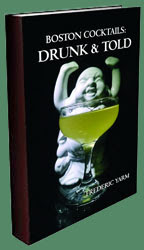3/4 oz Lime Juice
3/4 oz Grapefruit Juice
3/4 oz Honey
1 oz Light Puerto Rican Rum (Tommy Bahama White Sand)
1 oz Dark Jamican Rum (Appleton VX)
1 oz Demerara Rum (Lemon Hart 80)
1 oz Club Soda
Heat honey until liquid and mix with juices and rum. Shake without ice until honey is mostly mixed. Add ice and shake again. Add soda water and pour into double old-fashioned glass filled with crushed ice or ice cone with straw. To make ice cone, pack a Pilsner glass with shaved ice and poke a hole with a chopstick down the center. Gently remove ice cone and freeze overnight (read text for other options).

Sunday night was Tiki night at our kitchen. I had been eying Don the Beachcomber's Navy Grog recipe in Beachbum Berry's
Grog Log for a while, and recently had been perfecting my ice cone making technique. And on Sunday, I finally had a pair that were viable. Neither my Ice-O-Mat crusher nor my Lewis Bag and mallet yielded "shaved ice" so packing it down like snow did not work. I did not try our blender which might have worked better than the hand-powered methods and the thought of waiting for the first good snow fall did cross my mind. My solution was to wet the ice bits down with cold water, pour off the excess liquid, and fill up my makeshift molds. The ice once refrozen adhered too well to the Pilsner glass and made extracting it in one piece difficult (and without the wet ice, it did not stay together well either). My solution was to cut the bottom off of a half liter Poland Spring seltzer bottle. The plastic bottle allowed me away to squeeze the ice out as well as to remove the cap and push from the bottom. As for the chopstick, I found that leaving it in for two hours with a wiggle every 30 to 60 minutes prevented the chopstick from sticking (I was using wood; plastic would probably stick less). After that, I removed the chopstick and let the wet ice refreeze for several hours more. Making the cone should not have been that difficult, but having the wrong form of ice certainly made things a challenge.
But finally, Navy Grog! The drink was very rummy with rich dark rum notes standing out in the beginning of the sip and white rum heat on the swallow. When I asked Andrea what she thought of the fruit flavors, her response was, "There's juice in here?" Although after a few more sips, whether through ice melt diluting the grog or through our taste buds acclimating, the citrus and honey flavors became evident. Overall, the Navy Grog was rather pleasant, and I would be rather satisfied if it were hot out. However, it was a chilly night in late November, and I felt that the drink could use some flair whether through a barspoon of allspice dram or a few dashes of pastis or bitters (*). Next time I will try an ukulele soundtrack to see if it aids my tropical island imagination and saves me from the wintry mood.
(*) Post note: Fans of this concept can try Beachbum Berry's original
Ancient Mariner which is similar enough that Ted Haigh lists it as the Navy Grog recipe in the new edition of his book.
2nd post note: When I showed the photo of our Navy Grog to bartender John Gertsen, he quickly focused in our lime peel flag and commented how it reminded him of a Gin Pennant and immediately set off to fetch his copy of the
Mixologist which had a description of it.
Wikipedia describes the flag's meaning as "that the wardroom is inviting officers from ships in company to drinks... Originally it was a small green triangular pennant measuring approximately 18 by 9 inches, defaced with a white wine glass, nowadays the gin pennant is a Starboard pennant defaced with a wine or cocktail glass." And the
Mixicologist asserts that "Whenever and wherever a ship hoisted the pennant, it meant that it was time to 'come aboard for a drink'".




 2 oz Macallan 12 Year Scotch
2 oz Macallan 12 Year Scotch







 The theme for this month's
The theme for this month's 



















 1 1/2 oz Plymouth Gin
1 1/2 oz Plymouth Gin



 The 2017 collection of 855 drink recipes, bartender tributes, and essays on hospitality from CocktailVirgin's Frederic Yarm. Available at
The 2017 collection of 855 drink recipes, bartender tributes, and essays on hospitality from CocktailVirgin's Frederic Yarm. Available at  The 2012 collection of 505 drink recipes, techniques, and Boston bar recommendations from Frederic Yarm. Available at
The 2012 collection of 505 drink recipes, techniques, and Boston bar recommendations from Frederic Yarm. Available at 



